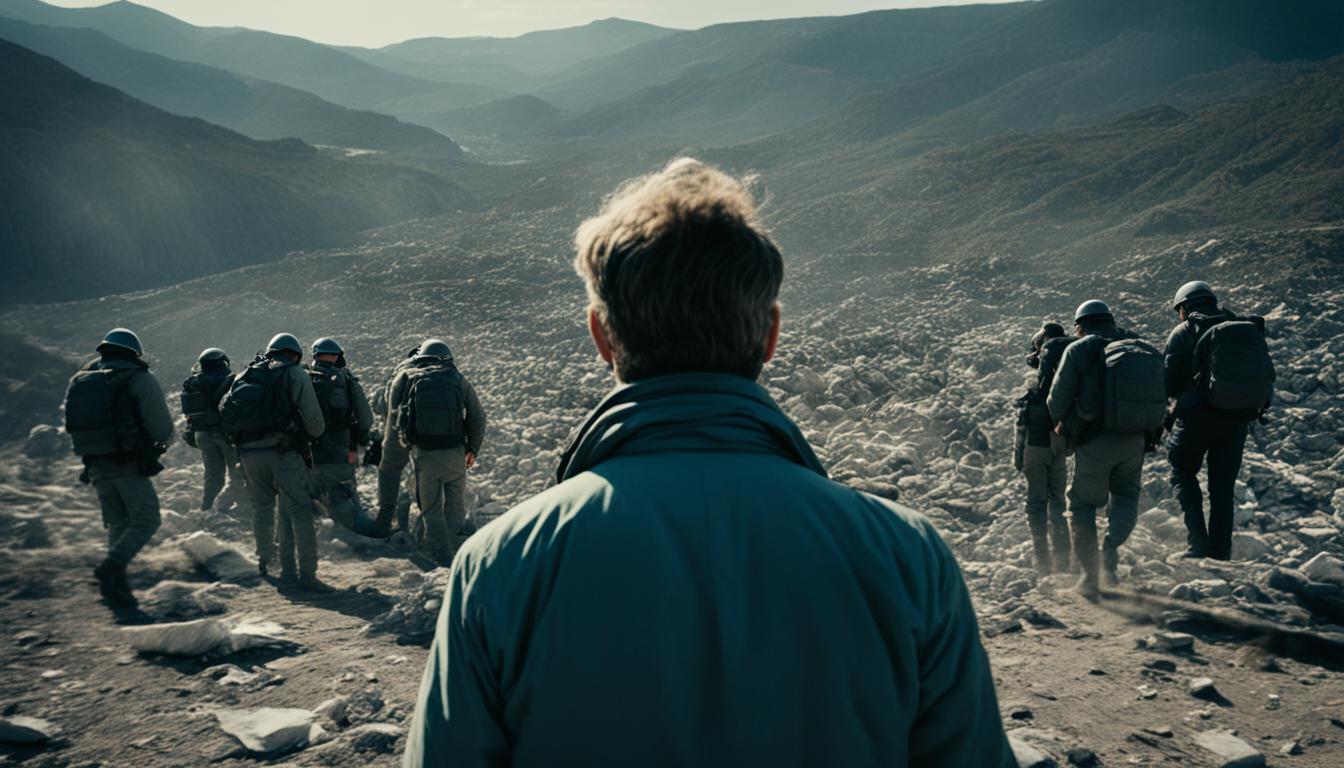Starting your journey in documentary filmmaking can feel overwhelming, but with the right research and preparation, you can ensure a compelling and well-grounded story. In this article, we will explore essential tips for researching and preparing for documentary projects. We will cover topics such as choosing a documentary narration style, using a three-act documentary structure, finding a documentary crew, creating a documentary treatment, developing a schedule and budget, selecting camera equipment, and starting the filming process. Let’s dive in!
Key Takeaways:
- Research and preparation form the foundation of a successful documentary project.
- Choosing the right documentary narration style is crucial in effectively telling your story.
- Using a three-act structure can help you map out the narrative arc of your documentary and keep your audience engaged.
- Assembling a skilled documentary crew is essential in bringing your vision to life.
- A well-thought-out documentary treatment acts as a roadmap for your filming process and helps communicate your vision to others.
Choose a Documentary Narration Style
Choosing the right documentary narration style is crucial in telling your story effectively. There are several styles to consider, including:
- Interview-led documentaries: These documentaries focus on interviews with key people, allowing them to share their perspectives and insights.
- Presenter-led documentaries: In this style, a narrator guides the viewer through the story, providing context and interpretation along the way.
- Observational-led documentaries: This style captures unscripted situations and events, offering a more natural and authentic portrayal of real-life experiences.
- Narrator-led documentaries: In these documentaries, a narrator provides additional information and commentary to enhance the storytelling.
Each narration style has its own unique advantages and disadvantages. By understanding the characteristics of each style, you can choose the one that best suits your documentary project. You can even experiment and combine elements from different styles to create your own unique approach, tailored to your story and vision.
Remember, the narration style you choose will significantly impact how your audience engages with the documentary and the overall impact of your storytelling.
“The way a documentary is narrated greatly influences the viewer’s understanding and emotional connection to the story. By carefully considering the narration style, you can effectively engage your audience and convey the intended message.”
-Sarah Thompson, Documentary Filmmaker
Use a Three-Act Documentary Structure
The three-act structure is a classic storytelling model that can be applied to documentaries. It divides your documentary into three parts: Act 1 (Setup), Act 2 (Development), and Act 3 (Climax & Resolution). In Act 1, you introduce your main characters and set up the conflict. Act 2 explores the conflict in more depth, introducing new characters and subplots. Act 3 resolves the conflict and ties up loose ends. Following this structure can help you map out the narrative arc of your documentary and keep your audience engaged.
By dividing your documentary into distinct acts, you create a cohesive and compelling story structure. Act 1 serves as the foundation, introducing the main characters and establishing the conflict or central question of your documentary. It sets the stage for what is to come and piques the audience’s curiosity.
Act 2 is where the story starts to unfold. This is the stage where you delve deeper into the conflict, exploring different angles and perspectives. You may introduce new characters or subplots that add complexity and enrich the narrative. Act 2 is often the longest part of the documentary, allowing for in-depth exploration and development.
In Act 3, the story reaches its climax and resolution. This is where you tie up loose ends, answer lingering questions, and provide closure for your audience. Act 3 is crucial in delivering a satisfying conclusion and leaving a lasting impact on your viewers.
Using a three-act structure in your documentary storytelling provides a clear framework for organizing your content and guiding the viewer through a cohesive narrative. It helps maintain a sense of progression and keeps the audience engaged from start to finish. Whether you’re exploring a social issue, documenting a personal journey, or shedding light on a historical event, the three-act structure can enhance the impact and effectiveness of your documentary.

Find Your Documentary Crew
Once you have your idea and equipment, it’s time to assemble a documentary crew. Building a strong team is crucial in creating a successful documentary film. You need like-minded individuals who are passionate about your topic and can contribute their skills and insights to your project.
When finding documentary crew members, consider the specific roles you need for your production. Think about positions such as editor, sound recordist, or cinematographer, and look for people who have experience in those areas. Each crew member brings a unique perspective and expertise to the project, enhancing the overall quality of your documentary.
Assembling a diverse and talented documentary team will not only make the filmmaking process more efficient but also increase the chances of creating a compelling and well-rounded documentary. Remember, collaboration and teamwork are essential in capturing the essence of your subject matter.
In my early days of documentary filmmaking, I learned the importance of finding the right crew members. While it can be challenging to find the perfect team, it’s worth the effort. I reached out to individuals who shared my passion for storytelling and had the skills required for their respective roles. This allowed us to work cohesively and bring the vision to life.
“A documentary crew is like a puzzle; each member contributes a unique piece, and when put together, they create something beautiful and impactful.” – John Smith, Award-winning Documentary Filmmaker
Qualities to Look for in Documentary Crew Members
When assembling your documentary crew, keep an eye out for the following qualities:
- Passion for the subject matter: Look for crew members who have a genuine interest in your documentary’s topic. Their enthusiasm will shine through in their work.
- Experience and expertise: Seek individuals who have experience in their respective roles. This could include prior documentary projects, relevant education, or technical skills.
- Collaborative mindset: A good documentary crew member understands the importance of teamwork and is willing to work together to achieve the project’s goals.
- Flexibility and adaptability: Documentary filmmaking often involves unexpected challenges. Crew members who can adapt to changing situations and think on their feet are invaluable.
- Attention to detail: Finding crew members who pay attention to the smallest details ensures the quality of your documentary.
By considering these qualities, you can find the right documentary crew members who will contribute to the success of your project and help you bring your story to life.
| Role | Responsibilities |
|---|---|
| Director | Oversees the creative vision of the documentary, guides the crew, and directs the storytelling process. |
| Producer | Manages the logistical and financial aspects of the documentary, including budgeting, scheduling, and coordinating with stakeholders. |
| Camera Operator | Captures high-quality footage using cameras and other equipment, following the director’s visual instructions. |
| Sound Recordist | Records clean and clear audio during interviews, scenes, and other audio elements of the documentary. |
| Editor | Crafts the narrative of the documentary by selecting and arranging footage, adding music and sound effects, and creating a cohesive story. |
| Researcher | Conducts in-depth research on the documentary’s subject matter, ensuring accurate and relevant information. |
Remember, finding the right documentary crew is a collaborative process. Take the time to communicate your vision, interview potential crew members, and assess their skills and alignment with your project. Building a team of passionate and talented individuals will make your documentary journey all the more rewarding.
Create a Documentary Treatment
A documentary treatment is an essential component of the pre-production phase. It serves as a roadmap for your documentary project, outlining its central focus, narrative, characters, themes, desired footage, and overall vision. The treatment provides a clear direction for your filming process and effectively communicates your vision to potential crew members or collaborators.
When creating a documentary treatment, it’s important to take the time to develop a well-thought-out outline that captures the essence of your story. Consider the following components:
- Main Characters: Identify the key individuals or subjects who will drive your documentary. Provide a brief introduction of each character, highlighting their relevance to the story.
- Key Themes: Determine the central themes and topics that your documentary will explore. These themes will guide your storytelling and shape your narrative.
- Desired Footage: Specify the type of footage you envision capturing to effectively convey your message. This could include interviews, location shots, archival footage, or specific events.
- Overall Vision: Describe the overall look and feel of your documentary. Consider the tone, style, and atmosphere you want to create to engage and captivate your audience.
By carefully outlining these key elements in your documentary treatment, you establish a clear foundation for the creative direction and execution of your project. It also helps potential collaborators understand your vision and contributes to a more efficient and collaborative filmmaking process.
“A well-crafted documentary treatment serves as the compass that guides our journey, ensuring we stay true to our storytelling objectives.” – Documentary Filmmaker
Below is an example of a documentary treatment outline:
| Documentary Treatment Outline |
|---|
| 1. Title of the Documentary |
| 2. Logline (brief summary of the documentary) |
| 3. Main Characters |
| 4. Key Themes |
| 5. Desired Footage |
| 6. Overall Vision |
Creating a thorough and well-structured documentary treatment sets the stage for a successful and impactful documentary. It aligns your team’s efforts, streamlines the production process, and lays the foundation for a compelling and engaging story.
Develop a Documentary Schedule & Budget
Creating a schedule and budget is a critical aspect of the documentary production process. It ensures that your project stays on track and allows for effective planning and resource allocation. By breaking down each stage of production into manageable tasks and setting realistic deadlines, you can ensure a smooth and efficient workflow.
When developing your documentary schedule, consider the following:
- Pre-production planning: This phase involves research, script development, location scouting, and casting. It sets the foundation for your documentary and determines the timeline for the subsequent stages.
- Production: This is the filming phase, where you capture the footage for your documentary. Consider the number of shooting days, the locations, and any necessary travel arrangements.
- Post-production: This phase involves editing, sound design, color grading, and adding any necessary visual effects. Allocate sufficient time for the post-production process to ensure a polished final product.
While creating the budget, be sure to consider all the necessary costs involved in each stage of production. These may include:
- Equipment rental: Determine the equipment you’ll need and research rental costs. Consider cameras, lighting gear, sound recording equipment, and editing software.
- Personnel fees: Account for the wages or salaries of the crew members involved in the production, such as camera operators, sound engineers, and editors.
- Travel expenses: If your documentary requires travel to various locations, factor in costs for transportation, accommodation, and meals.
- Post-production costs: Consider any expenses related to editing software, color grading, sound mixing, and music licensing.
- Contingency budget: It’s crucial to allocate a contingency budget for unexpected expenses that may arise during production. This ensures you have some flexibility to address unforeseen challenges.
By creating a well-planned schedule and budget, you can effectively manage your resources, keep track of costs, and ensure that your documentary stays on track from pre-production to post-production. Remember that careful planning and organization are key to a successful documentary project.

Choose Camera Equipment for Your Documentary
The choice of camera equipment is a crucial decision when it comes to creating your documentary. It will depend on your budget, technical requirements, and artistic vision.
While it’s important to have quality equipment, remember that skills and storytelling are more important than having the latest gear. You can still create a compelling documentary with whatever camera you have available, whether it’s a smartphone or a borrowed camera.
If you’re considering investing in camera gear, it’s essential to do thorough research to find one that suits your needs. Look for a camera that provides the desired image quality, low-light performance, and flexibility for different shooting scenarios. Consider factors such as lens options, audio capabilities, and ease of use.
Remember, it’s not about the camera you use, but rather how you use it to capture and convey your story. Focus on honing your skills as a filmmaker, mastering composition, lighting, and sound. Your ability to craft a compelling narrative and connect with your audience will ultimately determine the success of your documentary.
Choosing the Right Camera for Your Documentary
When choosing a camera for your documentary, consider the following factors:
- Budget: Determine your budget range and find the best camera within that budget. Remember, you may need to allocate funds for other essential equipment such as lenses, tripods, and audio gear.
- Technical Requirements: Assess the technical specifications required for your project. Consider factors such as resolution, frame rates, image stabilization, and low-light performance.
- Artistic Vision: Think about the visual style you want to achieve for your documentary. Consider the type of shots you’ll be capturing and whether specific camera features such as interchangeable lenses or manual controls are necessary.
It’s also worth noting that technology is constantly evolving, and new cameras are released regularly. Stay up to date with the latest advancements, but prioritize the features that are most relevant to your specific needs.
“The single most important component of a camera is the twelve inches behind it.” – Ansel Adams
Remember, your camera is just a tool. Focus on telling a compelling story through your footage and utilizing your creativity to craft a visually stunning and emotionally engaging documentary. With the right skills and storytelling techniques, you can create a documentary that captures the hearts and minds of your audience.
Conclusion
In conclusion, conducting thorough research and proper preparation are essential steps when embarking on a documentary project. By following the key tips we’ve discussed, such as choosing the right narration style, utilizing a three-act structure, assembling a skilled crew, creating a comprehensive documentary treatment, developing a realistic schedule and budget, selecting suitable camera equipment, and initiating the filming process, you can position yourself for success.
Remember, the heart of a compelling documentary lies in telling a powerful and authentic story. By dedicating time to researching your subject matter, interviewing key individuals, and immersing yourself in the topic, you can ensure that your film resonates with your audience and leaves a lasting impact.
So, whether you’re a seasoned filmmaker or a novice eager to make your mark in the world of documentaries, embrace the journey of documentary research and preparation. Armed with the tips and techniques shared in this article, you are well-equipped to create a documentary that captures the essence of your subject matter and captivates viewers.
So, grab your camera, immerse yourself in the world of your documentary, and let the power of storytelling guide your every step. Happy filmmaking!
FAQ
What are some essential tips for researching and preparing for documentary projects?
Some essential tips for researching and preparing for documentary projects include choosing a documentary narration style, using a three-act documentary structure, finding a documentary crew, creating a documentary treatment, developing a schedule and budget, selecting camera equipment, and starting the filming process.
What are the different documentary narration styles to consider?
The different documentary narration styles to consider include interview-led documentaries, presenter-led documentaries, observational-led documentaries, and narrator-led documentaries. Each style has its own pros and cons, and you can even combine elements from different styles to create your own unique approach.
How does the three-act documentary structure work?
The three-act documentary structure divides your documentary into three parts: Act 1 (Setup), Act 2 (Development), and Act 3 (Climax & Resolution). Act 1 introduces the main characters and sets up the conflict, Act 2 explores the conflict further with new characters and subplots, and Act 3 resolves the conflict and ties up loose ends.
How can I find a documentary crew for my project?
To find a documentary crew, consider assembling a team of like-minded individuals who are passionate about your topic and can contribute their skills and insights. Look for people with experience in roles such as editor, sound recordist, or cinematographer. Building a strong team is crucial in creating a successful documentary film.
What is a documentary treatment and why is it important?
A documentary treatment is an outline of the central focus and narrative of your documentary. It includes the main characters, key themes, desired footage, and overall vision. The treatment serves as a roadmap for your filming process and helps communicate your vision to potential crew members or collaborators.
How do I create a schedule and budget for my documentary?
To create a schedule and budget for your documentary, break down each stage of production into manageable tasks and set deadlines. Consider all necessary costs, such as equipment rental, personnel fees, travel expenses, and post-production costs. It’s important to allocate a contingency budget for unexpected expenses.
How do I choose the right camera equipment for my documentary?
The choice of camera equipment for your documentary depends on your budget, technical requirements, and artistic vision. It’s important to have quality equipment, but remember that skills and storytelling are more important than having the latest gear. Use whatever camera you have available, whether it’s a smartphone or a borrowed camera.
What are the key research and preparation steps for a documentary project?
The key research and preparation steps for a documentary project include choosing a narration style, utilizing a three-act structure, assembling a documentary crew, creating a documentary treatment, developing a schedule and budget, selecting camera equipment, and starting the filming process. These steps help ensure a compelling and well-grounded documentary.
Note: The answers can be expanded based on the writer’s knowledge and expertise in documentary filmmaking.




